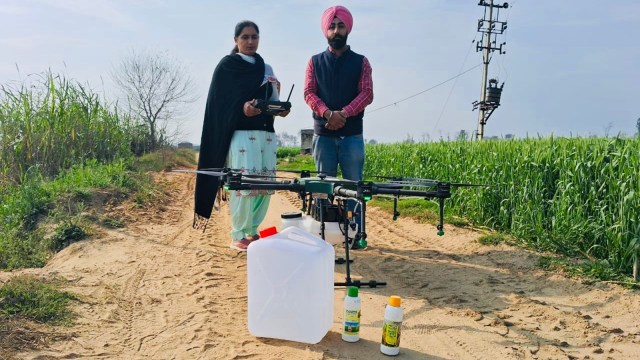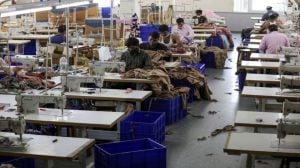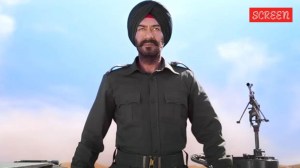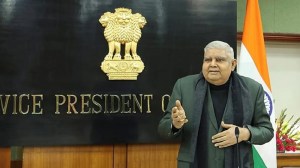In the face of on-ground challenges: How Punjab’s Drone Didis are going strong to script success stories
Prime Minister Narendra Modi had announced to train at least 15,000 Drone Didis across the country, ushering in a tech revolution in the agriculture sector by spraying fields with drones, thus cutting the cost of manual labour while saving time and water.
 Mandeep Kaur while spraying fields with a drone. (Express Photo)
Mandeep Kaur while spraying fields with a drone. (Express Photo)Trained as drone pilots under the Centre’s project NAMO Drone Didis to spray fields of farmers using unmanned flying devices, a handful of rural women from Punjab have started providing the service commercially and moving village to village to make farmers aware of the benefits of using drones for spraying pesticides/fertilizers.
Despite facing initial challenges — from lack of awareness about drones among farmers to their own domestic issues — some women who underwent training are scripting unique success stories by keeping their spirits high despite low pace of work. However, a few others have decided to give up after experiencing practical issues on the ground.
One such success story is that of Jaswinder Kaur Dhaliwal (46) from Rattian village of Moga who was among the first to be selected from Punjab for training under the NAMO Drone Didi project.
Class XII pass, Jaswinder runs 15 women’s self-help groups that make jute bags. Initially, she felt scared of even touching the remote control of the drone, which she felt was an “alien object” but after training in Gurgaon, her inhibitions were gone.
 Preeti of Moga while operating a drone. (Express Photo)
Preeti of Moga while operating a drone. (Express Photo)
Starting with commercial spraying of fields in June after getting a drone from Indian Farmers Fertilisers Cooperative Limited (IFFCO), she has made a decent beginning spraying over 200 acres for Rs 250 per acre. The cost of insecticides/pesticides to be sprayed is borne by the farmer.
“It’s not an easy job, but it is very much possible if we go to fields convincing farmers to use drones instead of manual labour, explaining to them the benefits of drone spraying — it spreads the insecticides/pesticides evenly across the field and saves a lot of time and labour. Manual spraying costs around Rs 200 per acre, but we are charging Rs 250 per acre due to additional costs like batteries, etc. Once farmers see how efficient the drone spraying is, they agree to pay Rs 50 extra. We request them to begin with one or two acres and get the rest of the spraying done if they are satisfied,” said Dhaliwal, adding the target is to cover 4,000 acres a year.
“On Monday, I booked 58 acres after the one-acre demo,” she said, adding, “Women who are going to fields and talking to farmers are running the project successfully while those who do not have contacts in villages or have limitations to move out are yet to catch up,” she said.
“Before training, I had only seen drones taking images in lavish Punjabi weddings. I was too scared when I touched the remote for the first time, but our trainers in Gurgaon were very nice. After clearing the theory, we were taught drone handling on a computer. A drone takes around seven minutes to spray an acre. Drones are being used to supply drugs in Punjab, but I think only women can stop the drug menace by engaging themselves in such positive work,” she said.
Of the 300 women trained across the country in the first batch under the Drone Didi project, 22 were from Punjab, 20 from Haryana and four from Himachal Pradesh.
Prime Minister Narendra Modi had announced to train at least 15,000 Drone Didis across the country, ushering in a tech revolution in the agriculture sector by spraying fields with drones, thus cutting the cost of manual labour while saving time and water.
 Jaswinder Kaur of Moga while operating a drone in a farmer’s field. (Express Photo)
Jaswinder Kaur of Moga while operating a drone in a farmer’s field. (Express Photo)
Mandeep Kaur (40), a graduate from Barundi village of Ludhiana, started getting orders from farmers not just from her village but across the district. She has covered over 120 acres till now. “Only in case of sugarcane, we ask farmers to pay Rs 300 per acre as drones consume more power. My husband deals in fertilizers and farmers keeps coming on a daily basis. So getting orders is not an issue for me,” she said, adding that now they are even getting orders from villages as far as 30 kms.
Mandeep said that some other women who also underwent training with her have left the project due to domestic issues. “One always needs a helper for this work. Some women have left it as it was getting difficult for them to manage alone. Also it takes a lot of time, which is difficult for rural women as they are also expected to cook, clean and take care of children at home. So some women who got training with us have left the project.”
Kiranpal Kaur (35) from Sekha village of Barnala who had taken her infant along during training to Gurgaon, said that initially she did spray 40 acres of maize field of a farmer but it was getting difficult for her to continue. “I cannot leave my child at home or carry him along to the fields. Earlier I thought I would manage but cooking, cleaning, handling a baby and then moving out in the fields is not manageable practically. I am ready to rent out the drone to the farmers.”
However, 20-year-old Preeti from Sosan village of Moga says that she won’t be leaving the project despite the slow pace of orders. “We knew this beforehand that drones aren’t popular and we have to work hard to convince farmers. It is getting better with time. However, a major issue is that we have been told to use IFFCO’s nano urea only and sometimes farmers aren’t convinced about it. They ask us to spray the products of their choice but the mobile app on which we have to update the area covered asks us to scan the IFFCO bottles,” said Preeti, who has covered 24 acres till now.













